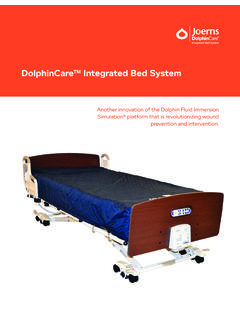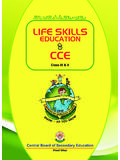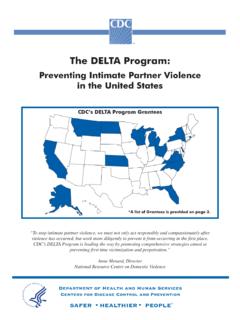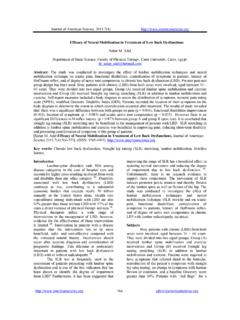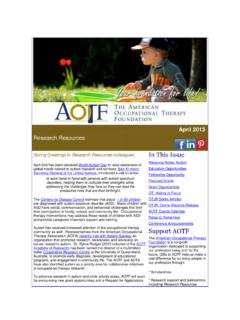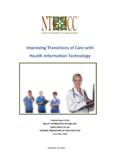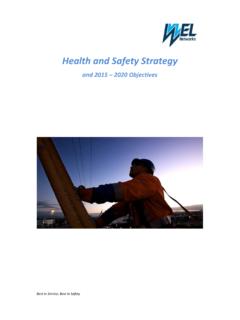Transcription of Manual handling training - Health and Safety …
1 Health and Safety Executive Manual handling training Investigation of current practices and development of guidelines Prepared by the Work and Health Research Centre for the Health and Safety Executive 2007 RR583 Research Report Health and Safety Executive Manual handling training Investigation of current practices and development of guidelines Cheryl Haslam, Stacy Clemes, Hilary McDermott, Kate Shaw, Claire Williams and Roger Haslam Work and Health Research Centre Department of Human Sciences Loughborough University Loughborough Leicestershire LE11 3TU This report presents findings of a systematic literature review, telephone survey and expert panels undertaken to determine what constitutes effective Manual handling training . The results of the systematic review indicate there is very little evidence supporting the effectiveness of both technique and educational based Manual handling training .
2 There was evidence that principles learnt during training are not applied in the workplace. Strength and flexibility training appears potentially beneficial, however further research is needed to determine whether it has long term benefits in terms of injury reduction. There was no evidence for the effectiveness of back schools in preventing low back pain. Ergonomics interventions that include risk assessment, observation of workers, tailored training and task/equipment redesign have been shown to be beneficial in the literature. The telephone survey indicated that induction of new staff and statutory requirements are the main drivers for Manual handling training . More than 75% of companies surveyed conduct in house Manual handling training rather than out sourcing training to consultants.
3 Most organisations and consultancies record participant feedback on training courses and sickness absence is regarded as the main outcome measure of effectiveness. Survey respondents felt that Manual handling training is more effective if it is tailored to specific industry and task demands. Practical elements in training were believed to reinforce learning, particularly if tailored to individual job demands. To be effective , Manual handling training needs to be embedded as an on going process in organisations and reinforced with regular refresher courses. training should encourage the workforce to assess risk and there needs to be careful monitoring of working practices. The expert panels reviewed the findings and the discussions were used to generate and refine a set of guiding principles for effective Manual handling training .
4 This report and the work it describes were funded by the Health and Safety Executive (HSE). Its contents, including any opinions and/or conclusions expressed, are those of the authors alone and do not necessarily reflect HSE policy. HSE Books Crown copyright 2007 First published 2007 All rights reserved. No part of this publication may be reproduced, stored in a retrieval system, or transmitted in any form or by any means (electronic, mechanical, photocopying, recording or otherwise) without the prior written permission of the copyright owner. Applications for reproduction should be made in writing to: Licensing Division, Her Majesty s Stationery Office, St Clements House, 2 16 Colegate, Norwich NR3 1BQ or by e mail to hmsolicensing@cabinet ii EXECUTIVE SUMMARY PROJECT AIMS This project aimed to establish what constitutes effective Manual handling training by reviewing the literature and by conducting a survey of current Manual handling training practices in organisations.
5 The results were presented to expert panels to validate the findings and to generate guiding principles for effective Manual handling training . METHOD A systematic review was undertaken to examine the evidence for and against the effectiveness and appropriateness of different approaches to training in Manual handling . A search strategy was devised to find research relevant to the review aims. Peer reviewed publications, published conference proceedings and reports from Health and Safety agencies (published between 1980 to 2006) on the topic of Manual handling training were reviewed. A published checklist for reviewing papers was used as a basis for assessing the quality of the papers reviewed.
6 A telephone survey was also conducted to investigate current practice with regard to Manual handling training in the UK. Interviews were conducted with representatives from 120 organisations across a broad range of industrial sectors. Thirty interviews were conducted with representatives from consultancies offering Manual handling training . Finally, two expert panels were conducted to validate the findings from this research and to generate guiding principles for effective Manual handling training . FINDINGS The systematic review covered: Manual handling interventions and the effectiveness of training in healthcare workers; the effectiveness of Manual handling training and interventions in non healthcare workers; the effectiveness of exercise/physical training on Manual handling capability; the effectiveness of the back school approach for treating and preventing Manual handling injuries; and the effectiveness of ergonomics training and ergonomics interventions on Manual handling .
7 The literature review identified 84 papers, comprising 50 intervention studies; 22 papers describing questionnaire based surveys or audits assessing the effectiveness of prior Manual handling training and 12 reviews or reports detailing the views of expert groups on Manual handling training . The results of the systematic review indicate that there is little evidence supporting the effectiveness of technique and educational based Manual handling training . There was considerable evidence that principles learnt during training are not applied in the working environment, there is little transfer of training from the learning environment to the working environment. Strength and flexibility training appear to offer benefits, although further research is needed to ascertain whether such interventions are sustainable over the long term, and whether there are long term benefits in terms of injury reduction in an occupational setting.
8 There was no evidence of the effectiveness of back schools for preventing low back pain. Evidence does exist that multi-element ergonomics interventions, particularly those that include risk assessments, the observation of workers in their working environment, the tailoring of training to suit individual needs, and the redesign of equipment and handling tasks can be effective in reducing the risk of Manual handling injuries. iii The telephone survey indicated that induction of new staff members and statutory requirements are the main drivers for Manual handling training . Most training is conducted on an annual basis and comprises half a day in duration. More than 75% of companies surveyed conduct in-house Manual handling training .
9 Of the training consultants interviewed, only 2/3 reported that they conduct a site visit prior to conducting Manual handling training . The majority of Manual handling training programmes incorporate some practical elements. Most organisations and consultancies record participant feedback on training but only 2/3 of consultants follow-up organisations to establish the effectiveness of their training . In terms of organisations monitoring the effect of training , sickness absence records are regarded as the main outcome measure. Respondents in the telephone survey considered that Manual handling training is more effective if it is tailored to specific industry and task demands. It was felt that a practical element to the training can help to reinforce learning, particularly if it is tailored to individual job demands and uses familiar equipment relevant to their work.
10 Manual handling training was thought to be effective only if adequately reinforced with suitable materials and ongoing support within the organisation itself. Trainers with experience and knowledge of a particular industry may have a greater understanding of specific risks within an organisation and this may lead to more effective training . Respondents believed that Manual handling training would be more effective if refresher courses were offered to employees on a regular basis to update and reinforce their learning. The expert panels stressed the need to promote the right culture to achieve safer working practices. They cautioned against treating Manual handling training as an 'annual chore' and stated that Manual handling training needs to be an integral component of organisational practices with regular refresher components, as part of an overall Manual handling risk assessment strategy.










